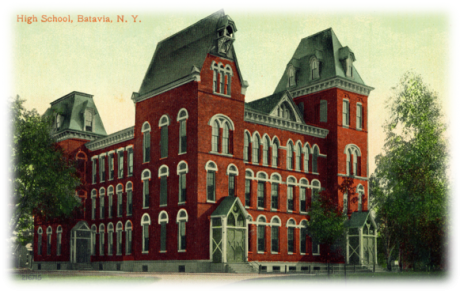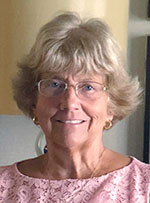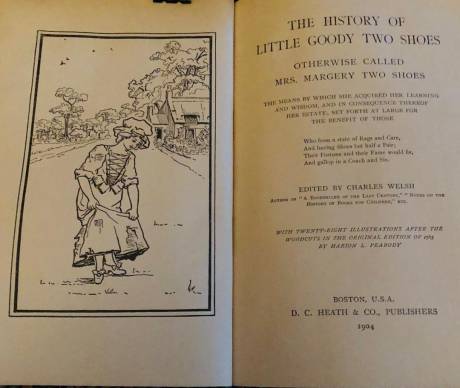

A couple of months ago a friend contacted me and asked if I would like a book from the Union School. I immediately said, “yes.” When I taught at Robert Morris School there was a painting of a very impressive red brick school called Union School. I always thought there was another school on Union Street besides Robert Morris. When I began researching schools for my book, I learned the impressive school did exist in Batavia but on Ross Street.
Here is a brief timeline of the schools in Batavia. As Western New York was settled in the 1700s, the first thing on a settler’s mind was to build a home for the family and gardens or crops to feed them, but no community was complete until a church was built and soon followed by a schoolhouse.
By 1798, there were 1,352 schools in the Holland Land Purchase (the area sold and administrated from the Holland Land Office in Batavia). Within 40 years (by 1838) that number increased almost tenfold, to 10,583.
The first brick school was constructed in Batavia in 1811. It had the public school downstairs and a meeting place for the Masonic Lodge upstairs. In 1829, the school district was divided between west of Dingle Alley and east of Dingle Alley. That would be the intersection of East Main and Center Street.
In 1839, the districts were consolidated and Batavia’s First Free Union School District 1 was built. In 1861, District 2 was combined with District 1. As a result, overcrowding occurred and the need for a new school was inevitable. The school district purchased land on Ross Street and in 1873 the red brick high school was built. It opened in 1874.
It was demolished in 1926 and was replaced with a new high school, currently the Batavia Middle School. The book I mentioned in this article was from the first high school that had the impressive red brick façade and towers. The book is stamped Union School 1905. The title of the book is, "The History of Little Goody Two Shoes," published in 1900. The book is dedicated "To All Young Gentlemen and Ladies who are good or intend to be good."
In 1911 the district was combined with one superintendent in charge of all schools. In the City School District, there was a high school, five elementary schools, the school for the blind and one Catholic school with students to 12th grade. By 1920, 400 students attended the high school; it was overflowing.
In 1921, 30 students had to go to vacant classrooms at East school. In 1920 the high school was built. There were five elementary schools and only one had been built in the 1900s. Washington was built in 1885 and had four rooms. In 1903 H. W. Homelius built a new school that had two floors and eight classrooms. It opened in 1904. Also built at the same time was Pringle School and William Street School. Washington School was built in 1885. East School and West School were built in 1892.
In 1925 Jackson School would be built to replace William School and Pringle School. In 1929 Brooklyn School, Robert Morris, and Jackson school opened. In 1939 Jackson School was enlarged and opened as a junior high school. By 1948 all city schools were crowded. Students were bussed to less crowded schools. Parents protested, they wanted their kids in their neighborhood schools.
Temporary schools were created at East School and Washington School. In 1950, city council offered to the City School District a site on Vine Street for a new school. Pringle school closed and was razed in 1954. Lincoln School closed in 1960. Children living south of Ellicott Street went to Jackson School, which was no longer a junior high school. A new school was to be built on Vine Street, called John Kennedy School, named after the superintendent John Kennedy who served from 1890 to 1930.
As public schools were being built, so were parochial schools. St. Joseph School opened in 1882, Sacred Heart School in 1904, St. Anthony’s School in 1930, St. Mary’s School in 1951, and Notre Dame High School opened in 1952. St. Joseph School is currently the only Catholic Elementary School in Batavia along with Notre Dame High School.
In 1961 the current Batavia High School was built on State Street. The high school on Ross Street was changed to a middle school. A new school for B.O.C.E.S. was also built on State Street and opened in 1976. In 1972 the new Genesee Community College was built.
In 2014 Robert Morris School closed. Jackson School became the district primary school and John Kennedy School became the intermediate school.
Even though the earliest history of the various schoolhouses throughout the region had similar stories with varied locations and different building designs, they all were built for the same reason -- to educate the children in what is today our city schools.
I attended East School, John Kennedy School, St. Joseph and Notre Dame High and I taught at Jackson School, Robert Morris School and John Kennedy School. I am currently on the faculty at St. Joseph School.


Good story
Good story
I enjoyed the read being a
I enjoyed the read being a product of the Batavia school system. John Kennedy to St Joe's to Notre Dame, 13 years growing up in Batavia. Thank you!